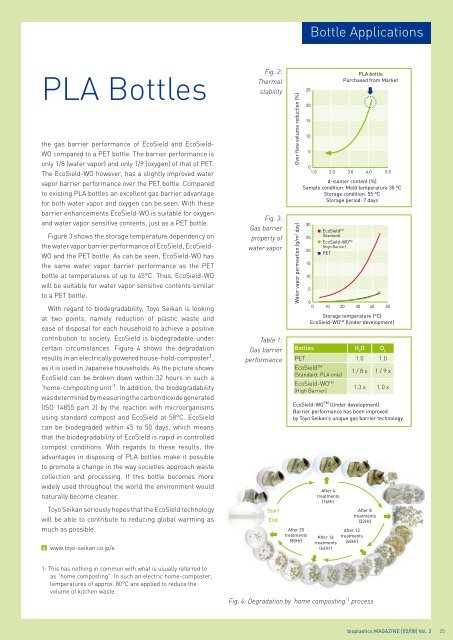05 | 2008
You also want an ePaper? Increase the reach of your titles
YUMPU automatically turns print PDFs into web optimized ePapers that Google loves.
Bottle Applications<br />
PLA Bottles<br />
the gas barrier performance of EcoSield and EcoSield-<br />
WO compared to a PET bottle. The barrier performance is<br />
only 1/8 (water vapor) and only 1/9 (oxygen) of that of PET.<br />
The EcoSield-WO however, has a slightly improved water<br />
vapor barrier performance over the PET bottle. Compared<br />
to existing PLA bottles an excellent gas barrier advantage<br />
for both water vapor and oxygen can be seen. With these<br />
barrier enhancements EcoSield-WO is suitable for oxygen<br />
and water vapor sensitive contents, just as a PET bottle.<br />
Figure 3 shows the storage temperature dependency on<br />
the water vapor barrier performance of EcoSield, EcoSield-<br />
WO and the PET bottle. As can be seen, EcoSield-WO has<br />
the same water vapor barrier performance as the PET<br />
bottle at temperatures of up to 45°C. Thus, EcoSield-WO<br />
will be suitable for water vapor sensitive contents similar<br />
to a PET bottle.<br />
With regard to biodegradability, Toyo Seikan is looking<br />
at two points, namely reduction of plastic waste and<br />
ease of disposal for each household to achieve a positive<br />
contribution to society. EcoSield is biodegradable under<br />
certain circumstances. Figure 4 shows the degradation<br />
results in an electrically powered house-hold-composter 1 ,<br />
as it is used in Japanese households. As the picture shows<br />
EcoSield can be broken down within 32 hours in such a<br />
‘home-composting unit’ 1 . In addition, the biodegradability<br />
was determined by measuring the carbon dioxide generated<br />
(ISO 14855 part 2) by the reaction with microorganisms<br />
using standard compost and EcoSield at 58°C. EcoSield<br />
can be biodegraded within 45 to 50 days, which means<br />
that the biodegradability of EcoSield is rapid in controlled<br />
compost conditions. With regards to these results, the<br />
advantages in disposing of PLA bottles make it possible<br />
to promote a change in the way societies approach waste<br />
collection and processing. If this bottle becomes more<br />
widely used throughout the world the environment would<br />
naturally become cleaner.<br />
Toyo Seikan seriously hopes that the EcoSield technology<br />
will be able to contribute to reducing global warming as<br />
much as possible.<br />
www.toyo-seikan.co.jp/e<br />
Fig. 2:<br />
Thermal<br />
stability<br />
25<br />
Fig. 3:<br />
Gas barrier<br />
property of<br />
water vapor<br />
Table 1:<br />
Gas barrier<br />
performance<br />
Start<br />
End<br />
Over flow volume reduction (%)<br />
Water vapor permeation (g/m 2 day)<br />
20<br />
15<br />
10<br />
5<br />
PLA bottle<br />
Purchased from Market<br />
0<br />
1.0 2.0 3.0 4.0 5.0<br />
d-isomer content (%)<br />
Sample condition: Mold temperature 30 ºC<br />
Storage condition: 55 ºC<br />
Storage period: 7 days<br />
30<br />
25<br />
20<br />
15<br />
10<br />
5<br />
EcoSield TM<br />
(Standard)<br />
EcoSield-WO TM<br />
(High Barrier)<br />
PET<br />
0<br />
0 10 20 30 40 50<br />
Storage temperature (ºC)<br />
EcoSield-WO TM (Under development)<br />
Bottles H 2<br />
O O 2<br />
PET 1.0 1.0<br />
EcoSield TM<br />
(Standard: PLA only)<br />
EcoSield-WO TM<br />
(High Barrier)<br />
1 / 8 x 1 / 9 x<br />
1.3 x 1.0 x<br />
EcoSield-WO TM (Under development)<br />
Barrier performance has been improved<br />
by Toyo Seikan’s unique gas barrier technology.<br />
After 20<br />
treatments<br />
(80Hr)<br />
After 4<br />
treatments<br />
(16Hr)<br />
After 16<br />
treatments<br />
(64Hr)<br />
After 12<br />
treatments<br />
(48Hr)<br />
After 8<br />
treatments<br />
(32Hr)<br />
1: This has nothing in common with what is usually referred to<br />
as “home composting”. In such an electric home-composter,<br />
temperatures of approx. 80°C are applied to reduce the<br />
volume of kitchen waste.<br />
Fig. 4: Degradation by ‘home composting’ 1 process<br />
bioplastics MAGAZINE [<strong>05</strong>/08] Vol. 3 25


















